As is often the case every year, this year is unique & something we haven't experience in quite a few years with the level of heat & humidity combined to sometimes mistake Chicago for a subtropical region. Prior to July 4th, I thought I had hit the weather lottery with sufficient rainfall combined with moderate temperatures leading to fast & firm conditions. We controlled the water not Mother Nature which lead to excellent turf health parleying into fairways & greens that rolled like a dream.
While turf health is still well beyond excellent and what would be expected come August after battling the heat & humidity; green speeds are what sufferers. This has been the ongoing sentiment since Mid July & especially after the heavy rains that left the course breathing for air.
12 Island Green?
15 Fairway Lake?
The heat we can combat if we have control of the water but when the heavy rains were followed by the high levels of humidity the battle became about survival knowing green speeds experience earlier in the year were out of our control without risking brown vs green turf. We successfully won the back to back weekends of floods by clearing all surface water via trash pumps.
This prevented the turf from being scalded but with the ground saturated with water & high temperatures root mass was lost in our Poa population which represents 60-80% of our course. Poa is a fine playing surface in the proper weather environment but as has been discussed in previous posting is not a tolerate grass species to the extremes of weather be it cold or hot.

These circumstances lead to a higher frequency of hand watering to maintain green, tee, & fairways surfaces due to the loss of root mass within our Poa population.
Monitoring Moisture with the Meter
Hand watering allows us to control where the water is applied vs the overall surface if irrigation system is used.

Link to USGA Article on Water Managment:
This is especially true on greens as the margin of error during these days with high level heat & humidity are razor thin as one day of not being vigilant can lead to turf much less desirable than a slower putting surface.
Below is an excerpt from Dr. Nangle with the C.D.G.A. & his weekly scouting report which puts this into perspective.
"This week will have brought up a question that many have not heard for a few summers based on the weather we have seen over the last three years. ‘Why are the greens slow’? Generally a superintendent doesn’t take the comment / question lightly and the answer is both difficult to explain and also hard to understand. Ultimately the bottom line is this – turfgrass plants are not losing water as rapidly as what they would when at normal levels of humidity, combined with this was rainfall on Wednesday and Thursday of a higher content that was desired for many. The consequence is twofold, superintendents cannot dry out the surface consistently across all 18greens unless they have a vacuum system installed and it means that turfgrass leaves become larger and ‘fatter’ than normal as water has completely filled the internal leaf structure – creating greater friction than normal on a golf ball – slowing it down. Well why not mow it lower you say – short answer is because no one wants dead grass. The long answer is – with golf and heat, we are exposing the growing point (crown) of the turfgrass plant to even more detrimental conditions (remember cutting turfgrass at 0.1” on a daily basis is akin to cutting your little finger every day for 20 years – if anyone can do that and retain their little finger in perfect condition after 20 years let me know). So like the Open Championship last week where a certain Mr. Stenson hit –20 despite slow and somewhat bumpy greens – players must adjust – get out on the practice green before playing and notice two things – how smooth the surface is and how alive it is – the speed you have to adjust to!"
Dr. Nangle
This excerpt gives both physiological part the living grass plant is experiencing but also how to compare it to something we experience with our living human body.
High heat & humidity we all experience everyday when conditions are like this when we walk out the door & can be seen with the marks left on our shirts from our bodys perspiration. This added moisture both on the turf grass plant & retained within the plant create this resistance to ball roll which creates slower putting surfaces. We have maintained the same mowing height since Mid April & continue to mow & roll on the weekends as well as for special events as we have since Mid April. So why are the greens slower if the Grounds Dept. is performing the same tasks that lead to the membership raving about how fabulous the greens were prior to the heat & humidity? As stated above by the help of the USGA & Dr. Nangle......Mother Nature always tends to decide ultimately.
Link to USGA Article on Green Speeds:
I hope this brings to light some knowledge in helping to explain how the unique weather pattern over the past 3-4 weeks has such a negative affect on greens speeds. I will continue to make smart choices that maintains healthy turf surfaces & not become reckless with pushing limits that I have seen & experienced and the aftermath that affects the back end of the golf season.
Soon the weather will transition into more favorable conditions & the golf course and it's putting surfaces will return to what we have come to expect.
Respectfully,
Kurt Sams, CGCS





































